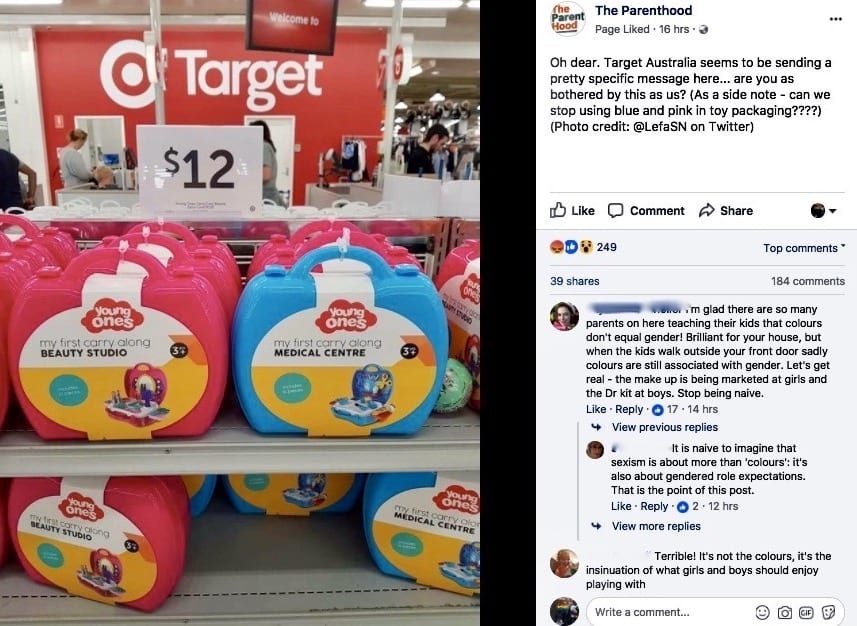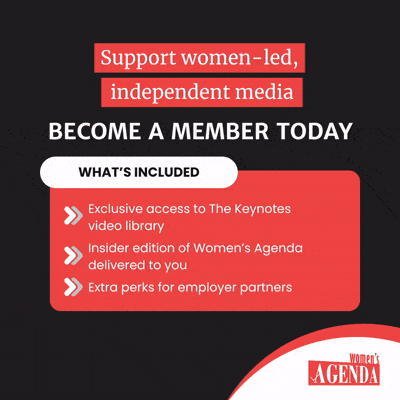Target Australia is currently selling a ‘my first carry along beauty studio’ and a ‘my first carry along medical centre’. Nothing too exciting or out of the ordinary, except that the colour of the beauty studio is pink and the medical centre blue.
This sparked feverish debate amongst our online community with many sharing a concern about the message the use of the colours sent around gender stereotypes and gendered role expectations. That as a pink case the beauty studio was clearly being marketed to girls and as a blue case the medical kit a great toy for boys. Accordingly, reinforcing in the minds of our kids that women are all about beauty and men are all about work and the medical profession. Clearly pretty problematic.
Yet, understandably there were just as many parents who were shocked we’d even raise it as an issue – pink and blue are just colours, parents can buy which ever toy they want for either their son or daughter, that this is just political correctness gone mad.
As a mother of two young girls I can honestly say my immediate reaction was so what. So, the medical kit is blue this wouldn’t alter my view one iota that this would be a toy my four-year-old daughter would love to play with. This is despite the fact she LOVES the colour pink and would most likely be attracted to the beauty studio for that reason, even though she shows no interest in make-up, because well, she’s four!
But just because as a parent I don’t buy into the gender stereotyping of toys nor how stereotypes are used in toy marketing, I know my daughters will see and hear differently outside the home.
As such the real issue with the Target toy display for me is, as one parent commented, – ‘…not the colours, it’s the insinuation of what girls and boys should enjoy playing with’.
There is no denying that pink is considered a girl’s colour and blue a boy’s and that these colours are especially used to distinguish the genders in early childhood.
I know this because every time I have my six-month-old daughter dressed in blue I’m told by strangers what a cute little boy I have (my daughter is very cute).
So, when one toy is coloured pink and the other blue it’s not too far of a stretch to suggest clearly one is being marketed as a girl’s toy and the other a boy’s one.
There is also no denying that we treat children differently based on gender. Don’t get me wrong, boys and girls are different and it’s completely fine to acknowledge the difference between the genders. Research shows that from birth there is a difference in what girls and boys show interest in, how they begin to interact with the world and what they prefer.
However, this difference is relatively minor, there’s actually greater variety in what kids are interested in within their own gender then compared with the other. But ‘we’ – parents, other family members, friends, kindy’s, media, marketing and society in general, are pretty quick to accentuate gender differences.
That is, we help guide what we think girls and boys “should” be interested in as well as responding to what they actually ‘are’ interested in. And we do so in a way that mirrors our lives and the roles men and women play in life.
And I think this is really important to highlight because it is through play that children create, explore, engage and interact with the world to learn how the world works and how they fit in with it all.
What children play with and how they play has a direct influence over their cognitive, emotional and physical development. Kids learn through play.
Play allows kids to practice adult roles. The toys kids play with matter.
But toys don’t have a gender – every variety of toy can be enjoyed by either gender. As the saying goes, if it is a boy toy or a girl toy it’s definitely not a children’s toy.
However, how children’s toys are marketed can and is very gender specific and this can help create a gender divide in the types of toys boys and girls end up playing with most. It also provides a helpful guide for the adults wishing to get the perfect toy, one their boy or girl should like and enjoy playing with.
Marketing both shapes and is shaped by public perception and community expectation. Not necessarily what children actually want, but rather what they’re expected to want. After time and enough exposure what kids want and what they’re expected to want often then become one in the same.
The manufacturers of the ‘beauty studio’ coloured the toy pink because it’s widely accepted and so expected that this is a toy girls would enjoy playing with. This in turn helping many a grandparent, aunty, uncle or friend to see it as a great gift for the little girl in their life.
Following this same logic, it would appear that the ‘medical centre’ as a blue case, especially when sitting alongside a toy clearly being marketed to girls, is considered by the manufacturers as a toy for the boys – the ideal gift for all the little boys in your life.
And so, what does this say about public perception and community expectations? Women care a lot about makeup and beauty so girls will enjoy playing with toys that mirror this behaviour? And because men take on a great deal of the professional work in life, like becoming a doctor, a toy doctor kit would be best marketed as a boy’s toy?
There’s nothing sinister here – it’s just marketing reflecting child’s play imitating adult life. In which case does it help explain why we continue to see gender inequality perpetuated in our homes and across our workplaces as we set up from a young age what our kids should expect to be and like based on their gender?
Or actually, is this simply two different types of toys, both as cheaply made as each other destined for one play before all the pieces break or go missing. Nothing to do with perpetuating any social issue. One toy just happens to be the colour pink, the other blue not an issue to get riled up about – let kids just play with what they want to play with.
My sense is that we find ourselves somewhere in the middle.
One thing is certain, as parents raising the future leaders, doctors, nurses and make-up artists – we need to be ever vigilant that we don’t limit the creativity or aspiration of what our children grow up to be simply because of the type of toy they may have been ‘guided’ to play with.


